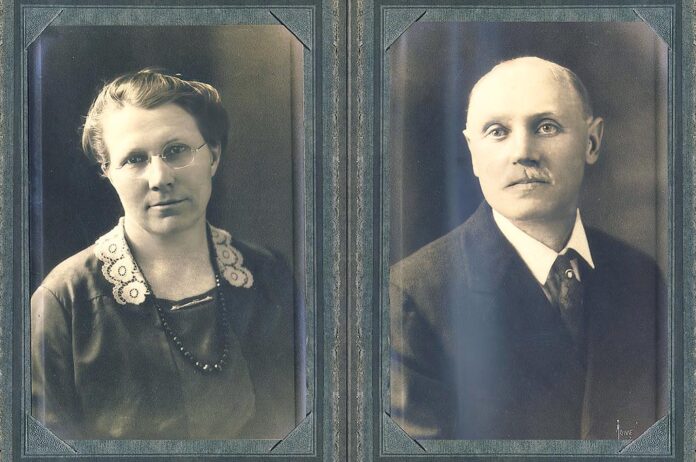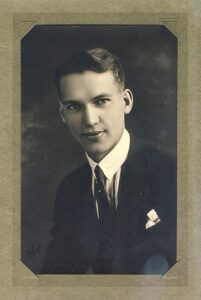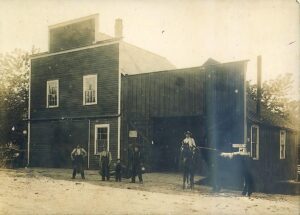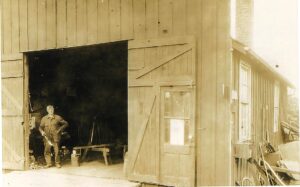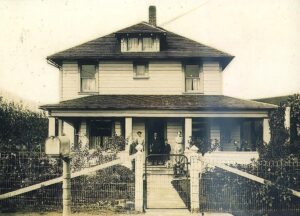The Village Blacksmith poem by Henry Wadsworth Longfellow immortalized the trade and character of the country blacksmith. Tigard’s early blacksmith was John Gaarde, for whom Gaarde street is named, and this same street is where his family lived. The poem opened—
“Under the spreading chestnut tree,
The village smithy stands,
The smith, a mighty man is he,
With large and sinewy hands,
And the muscles of his brawny arms,
Are strong as iron bands.”
The poem’s first stanza might have described Jorgen ‘John’ Nissen Gaarde, who had been born in Gabel, Schleswig-Holstein, Germany, which was originally a part of Denmark in 1864. He served as a medic in the German army and later was apprenticed to a blacksmith and migrated to America. He married Matilda Pederson, the daughter of Tigard Danish immigrants Hans and Ane Pederson, in 1893. Matilda had been born in Bernstorffsminde, Denmark, in 1873 and, with her parents, had immigrated to America. John and Matilda Gaarde had met in Oregon.
John Gaarde opened his blacksmith shop first in Garden Home in the 1890s and then moved his business to Tigard when he purchased a shop from Mr. Cooperstein and married Matilda. The Gaarde couple had four children, Anna, Elizabeth, Hans, and Marvin. John’s eldest son, Hans Gaarde, would carry on the family’s blacksmith business.
Tigard’s village blacksmith, John Gaarde, repaired all of the local farmer’s implements necessary for farming, like wagon wheels, buggies, plows, combines, threshers, scythes, bicycles, saws, and household tools like meat grinders. Importantly, he made horseshoes for the community’s most necessary form of transportation. John Gaarde was often seen inside his shop with a blowtorch in hand or hammering on his forge, tongs in one hand, hammer in the other near the fire. Anyone who knew John well saw his resemblance to the figure of the blacksmith in Longfellow’s poem.
“His brow is wet with honest sweat,
He earns whate’er he can,
And looks the whole world in the face,
For he owes not any man.”
“They love to see the flaming forge,
And hear the bellows roar,”
John Gaarde eventually diversified into an autobody repair and paint shop in Tigard when automobiles came into use in the 1920s. He invented new machines, such as a large saw that was powered by a car and fascinated the children.
Hans Gaarde, John’s son who inherited his business, married Hilma Lien, the daughter of Halvor and Gerstru Lien. Hans worked as a young apprentice in his father’s blacksmith shop and later became a dairyman at Red Rock Dairy. Like his father, Hans was a community leader and was well respected for his contributions to local projects. Hans served on the local school board from 1936 to 1942. Hans worked at the Diary until 1941, and during World War II, he worked in the Oregon shipyards. After the war, Hans worked for Del Monte Meat Company until 1963, when he retired.
Hilma Lien Gaarde was a member of Eastern Star and served during World War II as a lookout on Bull Mountain for enemy planes. Hans Gaarde, like his father, was a member of the Odd Fellows Lodge, and their wives belonged to the Rebekahs, both service organizations that aided the community. These groups were also social organizations and held dinners and meetings like the Grange, which was a political lobby for local farmers. John Gaarde’s grandchildren were Richard John Gaarde and Estelle Gaarde Rasmussen.
Longfellow’s poem was first published in 1840 and appeared in The Knickerbocker magazine, published in New York. Longfellow lived at the time in Cambridge, Massachusetts. The poem’s story offered a heroic figure and glorified the tradesman and the craftsman of the smithy.
Privately, Longfellow had written in his journal that the poem was a ‘Psalm of Life,’ and the closing lines of The Village Blacksmith poem championed hard work and opined:
“Thus at the flaming forge of life
Our fortunes must be wrought;”
Longfellow’s entire Village Blacksmith poem can be read online in the public domain and, like John Gaarde of Tigard, Oregon, provides an example of moral personal character and strong community leadership.
To become a member, volunteer, or for more information about the Tigard Historical Association visit www.tigardhistorical.org.






